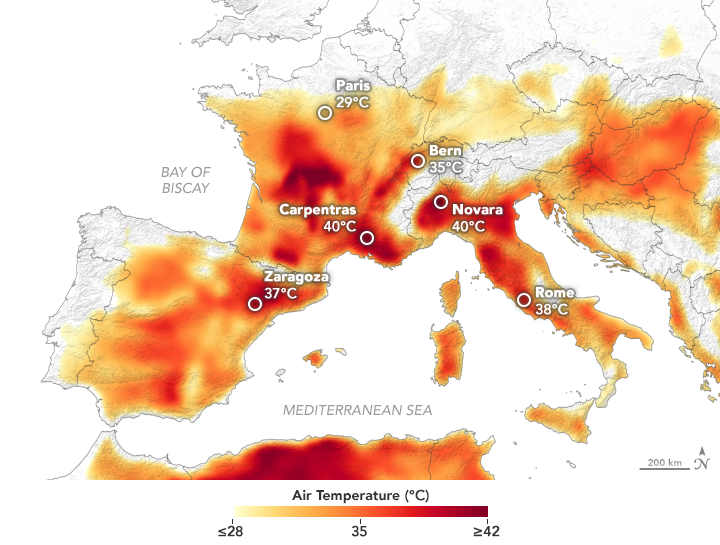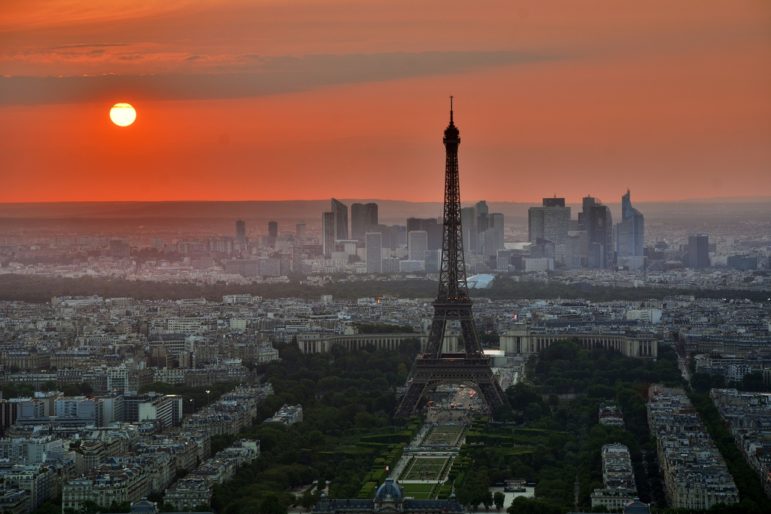
“I live on the seventh floor of a building with no fans or air conditioning,” my friend Brian tells me. Brian lives in Paris, part of an exchange program that sends doctoral students from the University of Missouri to France. “I have been just trying to escape the apartment until about 11:30, when it cools down a little. I’ve basically had to think about the heat all week and how I’m going to deal with it.”

Map of temperatures in Europe on June 27, 2019 (Wikimedia Commons)
At the end of June, France went through the hottest spell in its recorded history – 113 degrees Farenheit in Villevielle on June 28, 110 at Montpellier Airport, the last more than ten degrees hotter than its previous record. The heatwave affected almost all of Europe, whose temperature maps looked more like Rothko color fields than typical meteorology. One map I saw had only one small patch of green amidst the shades of orange and red, clustered around Tromso, Norway, about as far north as one can go and still call it “Europe.” And some observed rather more prosaic features in the map:
A gauche carte des températures à 1500m prévues par GFS. A droite le cri de Munch.
Jamais vu ça en 15 que je regarde des cartes météo #canicule pic.twitter.com/RIJTXiCUh1— Ruben H (@korben_meteo) June 20, 2019
Most articles on the heat wave seemed to choose photographs of Parisians diving into swimming pools and public fountains to illustrate the heat wave – and if one were only to consider the photographs, it didn’t look so bad. Many of us would appreciate having more city-wide pool parties. What’s less appealing, but more telling, is that so far four people in France have died of drowning, apparently lost while swimming in unsafe areas. (France24 reports that in addition to the four confirmed deaths by drowning, a six-year-old is in critical condition from injuries sustained after being hit with a pressurized burst of water from a fire hydrant that had been cracked open to provide relief from the heat.)
As yet we don’t know how many people perished from the heat wave itself, a figure that might take weeks to arrive at – but that number certainly isn’t zero. This won’t be the last great heatwave – if anything, last week was a preview of the world to come, and a reminder to the West of what the world already looks like in many parts of the Global South.
During the height of the heat wave, climate change activists from the group Extinction Rebellion occupied a bridge in Paris to demand the French government take swift actions to reduce carbon emissions. The police responded by tear-gassing the protesters, spraying directly into their faces in a manner that reminds me of the 2011 University of California pepper-spray incident. There is no pretense of “crowd control” at work here, no objective of “restoring order,” merely the cruel indifference of authority. The only “order” to restore is the one where we pretend this problem, this catastrophe, is one that does not exist.
As Pagans, we have no choice but to reject that order. Though the specifics differ greatly among the many traditions that we call “modern Paganism,” I’ve never met a Pagan yet who did not consider it important to be in a right relationship with nature. But at this juncture of history, not a single one of us can claim to have that relationship. This isn’t a statement of individual sins, but an observation of our collective responsibility for the state of the world we worship.
The past few centuries of human living – specifically, the way of life developed by wealthy, industrialized countries in the West – have not only alienated us from the natural world, but have ultimately despoiled nature in a way that is likely to kill most of us. That alienation and desolation was the spiritual foundation for the birth of modern Paganism in the first place; now it must be the catalyst for the Pagan movement as a whole to take action in the name of the spirits, wights, and gods with whom we seek connection.
I have struggled with this in my personal practice this past year. What good does it do for me to thank the land-wights at my altar? I find myself wondering. They suffer regardless of what I say there. To be frank, it has led me away from my altar altogether for some months; I have found that the altar represents a binary that cannot hold for me any longer, a dichotomy of sacred and profane that I can no longer accept. To the degree that magick is helpful at all in this moment, I can’t imagine it will make much of a difference when it is done alone in a darkened room. Whatever difference we are going to make, we are going to have to make it together, and it will involve confrontation with power.
Perhaps our rituals ought to involve occupying a few bridges.

Eiffel Tower at sunset (Pixabay)
That said, there are still occasional signs of possibility to be found if one is willing to look for them. While reading about the European heat wave, I came across this detail, hidden at the very end of an article on France24: “In Berlin, a police unit turned water cannons – usually used against rioters – on city trees, to cool them down.”
It’s not much consolation, perhaps – the water cannons, like the tear gas canisters, were designed for the state to repress the demands of protesters, and I’m sure they’ll be used for that purpose again soon – maybe even before the summer is up. But it’s a nice image, regardless, a water cannon used to cool the trees, like a sword beaten into a ploughshare.
May we repurpose all our mad weapons to such ends.
The Wild Hunt is not responsible for links to external content.
To join a conversation on this post:
Visit our The Wild Hunt subreddit! Point your favorite browser to https://www.reddit.com/r/The_Wild_Hunt_News/, then click “JOIN”. Make sure to click the bell, too, to be notified of new articles posted to our subreddit.
